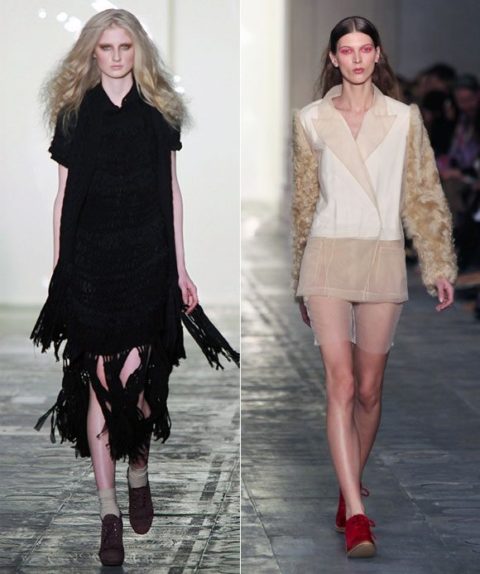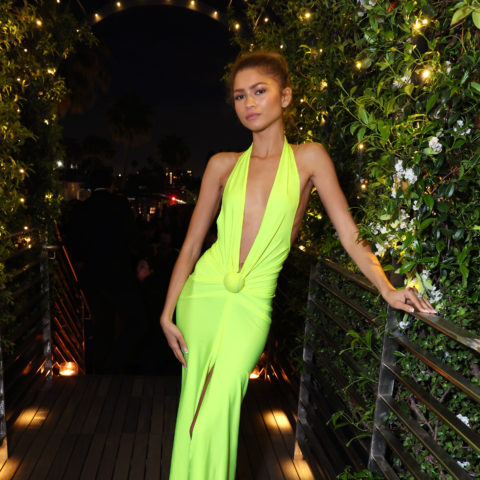LFW Diary: Spotting (or confirming) the ones to watch at Fashion East and Thomas Tait


“Why do you come to London? Is it the best for finding new designers?” I forget who asked me this the other eve⎯by now the whole week’s a blur of long skirts and spikes and unnaturally bright hair⎯but the answer is yes. It’s not the weather.
After a so-so Emilio de la Morena show⎯he went minimal-geometric with his party dresses, which doesn’t suit him well⎯I decided to make Fashion East my last show of LFW. Lulu Kennedy‘s ingenious new-talent showcase has been going ten years strong, and in the two previous seasons I’ve attended London, I’ve loved it. So I wanted to end on a high note, or, as it happened, a sugar-high note. The Topshop venue’s cafe is famously good, and free, and their final spread of champagne and sweets made myth of the idea that fashion people don’t do calories. The boy next to me, wearing a green Mongolian-fur cape, had four pieces on his plate. You want good reviews from even the nastiest critics? Let them eat cake.
First up: James Long, one of a handful of London boyswear designers who now want to know what it feels like for a girl. (I’ve already mentioned the delightful J.W. Anderson, who did his first womens presentation the other day and showed his menswear to all the pretty boys⎯and Hamish Bowles⎯this morning.) London guys are known for pushing boundaries in the mens department, but their forays into female dressing fall short of extraordinary. It’s not surprising: so much less has been done in menswear that it’s easier there to be “different.”
When the drumbeats came on, I feared Long’s womenswear would be “tribal,” that overused name for an overdone trend. A glance at the show notes, then to the runway, proved otherwise: “punk mountain” was Long’s given theme. That meant lots of alpaca knits and macramé fringe, with bright Guatemalan beading kept to a blessed minimum. There was a long slinky knit with a vintage Missoni vibe, and a cloud-white sweater that seemed to be falling apart in a Rodarte kind of way, as well as a simple take on the blanket cardigan, already a fall must-have. But what was new for knitwitted girls? A poncho lengthened to cover one’s lady parts does not a dress make.
Elliot Atkinson went on a (presumably figurative) journey to Native America, and came back with a lot of feathers. These he stuck to the bodices of unsophisticated little dresses⎯black, lavender, and a nice tartan⎯before calling it a day. I preferred the cowgirl side of this cowgirls-and-Indians game: skinny pants and sharp white shirts with lariats and boxy shearlings or blazers with fur upper (yes, just upper) sleeves.
Last and best was Simone Rocha, daughter of designer John Rocha, showing in her sophomore season at Fashion East. Her debut was all in Margiela whites and strived for that Belgian ideal of conceptual simplicity, with neat tricks of tailoring. Here she expanded her repertoire to include colours, patterns and new textiles, primarily fur which is a lot to do at once, but she handled it pretty coolly. Her shirts and shirtdresses had tall collar and laser-cut, unfinished hems. (As a new designer you need those signature details.) There was lots of flat tulle, wether layered under jackets, set right into them or wrapped over a cable-knit dress. I loved the tea-stained fur she used for jacket backs and strapless dresses⎯very Meret Oppenheim! And I wanted immediately the shoes: oxfords tipped onto perspex wedge heels for a double-take effect.
I said I was done. I even went to Rose Bakery in Dover Street Market and ordered ginger tea to wash down the week. Next to me was Diane Pernet, who was carrying the tartan CDG wallet I’ve been trying to find at home (“I got it as a present from Adrian Joffe,” she said, helpfully). It seemed a fitting end. And yet! Thomas Tait, the ex-Montrealer, youngest-ever Central Saint Martens grad, and⎯ahem⎯one of my Ones to Watch in this past April issue, was doing an off-off-schedule show. (Risky move, no? All the big eds were headed to Milan the next day… but Sally Singer and Meenal Mistry, to name just his fellow alliterates, showed face.) I felt weird about attending, knowing he’d hated my comparing his CSM grad collection⎯all black and, for lack of a better word, androgynous⎯to Rad Hourani‘s work. But I’m so, so glad I did go, because I’d never make that comparison now. Tait’s tailoring, strong from the start, has suddenly soared beyond belief. His folded skirts were more like fluid sculpture. He does with wool what Ghesquiere can do with neoprene.
Tait eschews influences, even references, but there was a distinct masculine/feminine feel, not to be confused with androgyny. He had taken the elements of a tuxedo and manipulated them into barely recognizable, beautiful new ideas. The lapels became those luscious thick folds on skirts, opening to reveal another layer, or trousers, beneath. The shiny cummerbund was reimagined variously as collar, cuff or belt. The finely pleated shirt became, say, the tail of a long cutaway jacket.
In fashion genres, Tait falls firmly under the “minimal,” but the word that comes to mind is pure⎯like Raf Simons at Jil Sander, or when he’s good, Stefano Pilati at Yves Saint Laurent. Speaking of Pilati, word he might be out at YSL makes me wish Tait was five to ten years older.







